Proposed Project Management Research: Agile SDLC Transition Topic
VerifiedAdded on 2022/10/14
|6
|1336
|200
Homework Assignment
AI Summary
This research assignment explores the transition to Agile SDLC (Software Development Life Cycle) within financial institutions. The paper begins by outlining the research process, including keyword searches and the use of resources like the HU library to narrow the research topic. It then defines Agile project management, highlighting its benefits such as shorter development periods, increased customer satisfaction, and reduced software defects, particularly in the context of the financial sector. The assignment also addresses the challenges financial institutions face when adopting Agile, including the need to adapt risk management, financial, and payment processing systems. It further discusses the advantages of Agile adoption, such as simplified software development, improved engineering discipline, and faster time-to-market. The paper explores methods for successful transitioning, including coaching, overall planning, and secure management commitment. It also examines the drawbacks of Agile, such as difficulties in developing complex financial systems and increased documentation needs. The assignment concludes by summarizing the impact of Agile adoption on efficiency and marketing time, while acknowledging the challenges and barriers faced by financial institutions, including regulatory compliance. References from various sources are provided to support the research.
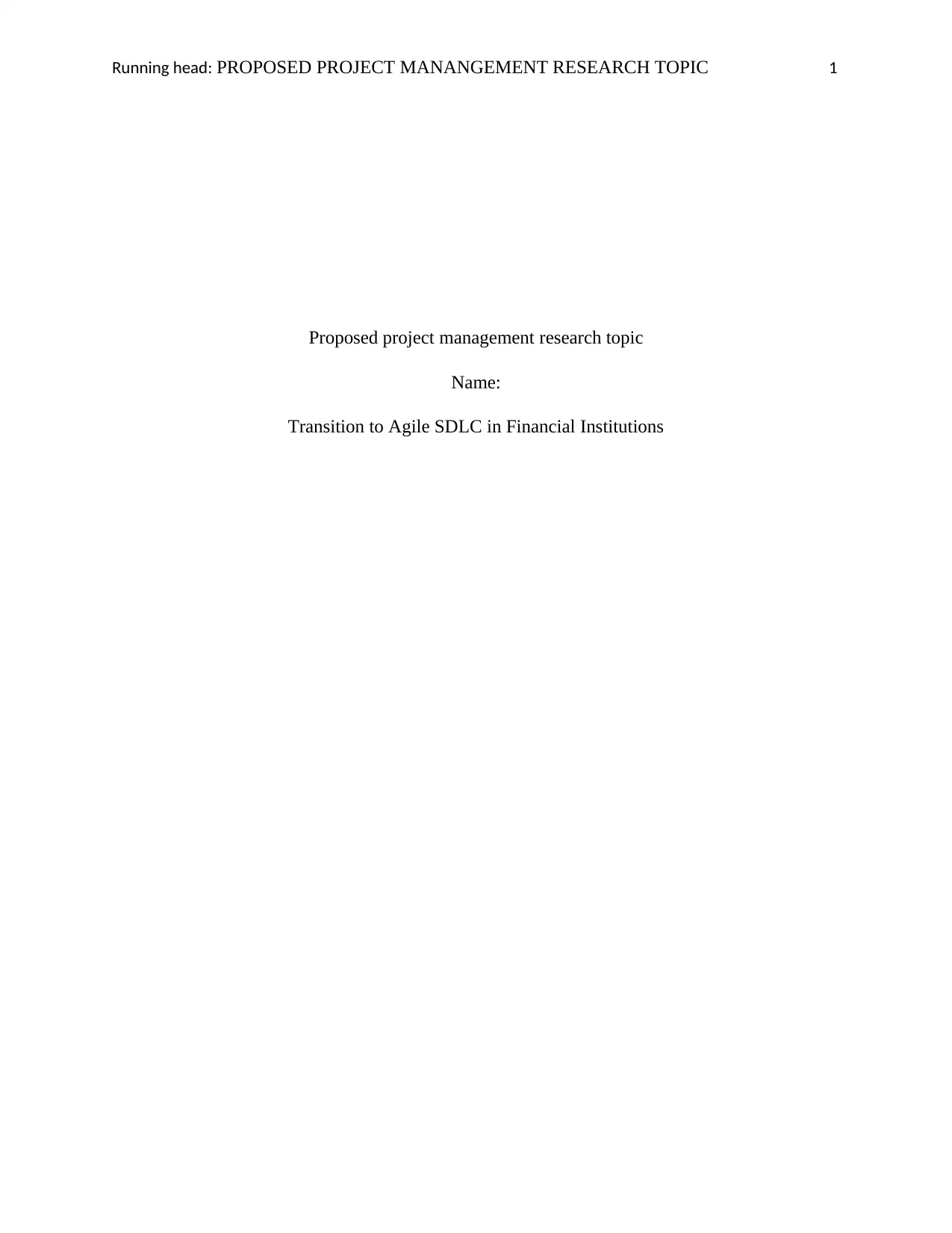
Running head: PROPOSED PROJECT MANANGEMENT RESEARCH TOPIC 1
Proposed project management research topic
Name:
Transition to Agile SDLC in Financial Institutions
Proposed project management research topic
Name:
Transition to Agile SDLC in Financial Institutions
Paraphrase This Document
Need a fresh take? Get an instant paraphrase of this document with our AI Paraphraser
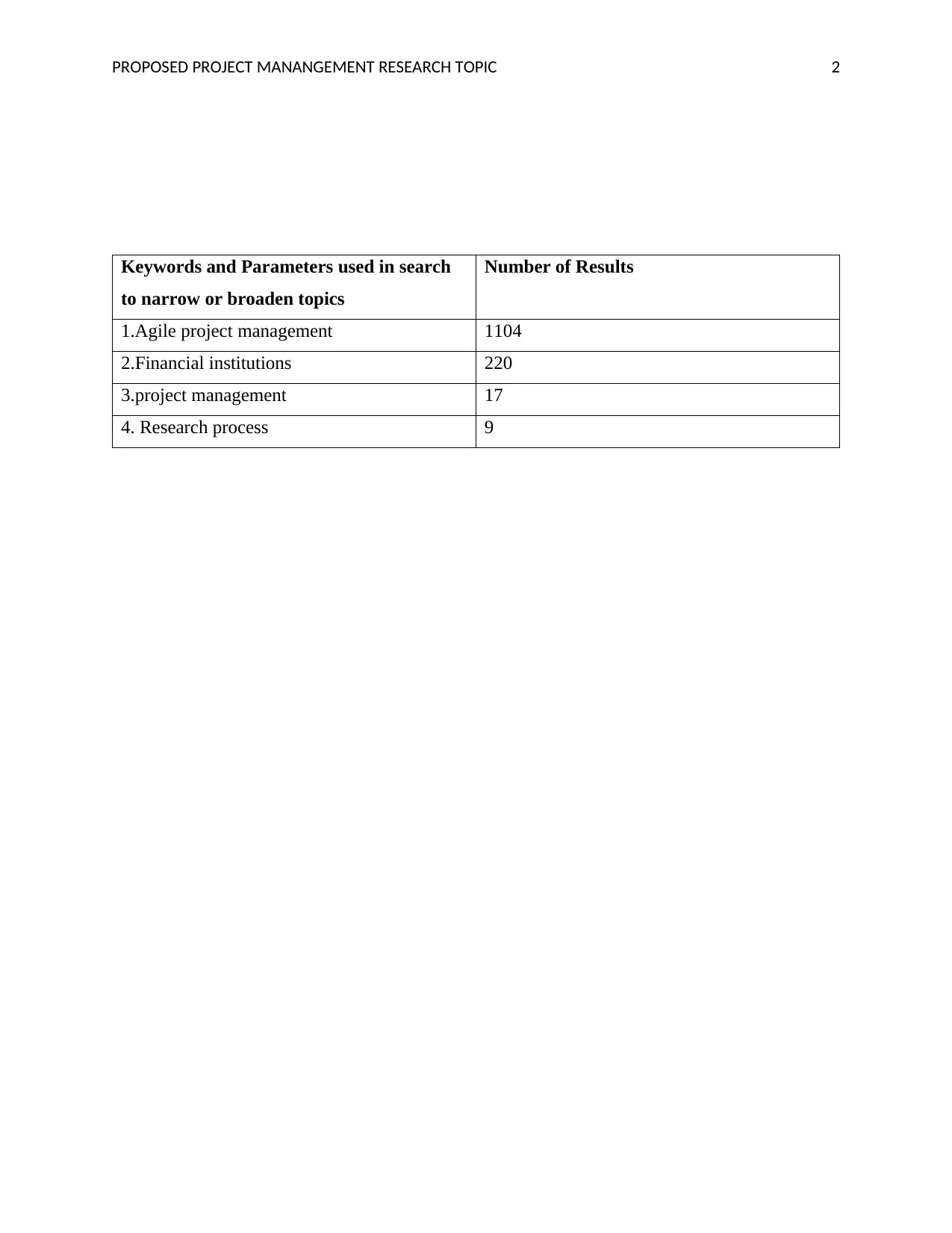
PROPOSED PROJECT MANANGEMENT RESEARCH TOPIC 2
Keywords and Parameters used in search
to narrow or broaden topics
Number of Results
1.Agile project management 1104
2.Financial institutions 220
3.project management 17
4. Research process 9
Keywords and Parameters used in search
to narrow or broaden topics
Number of Results
1.Agile project management 1104
2.Financial institutions 220
3.project management 17
4. Research process 9
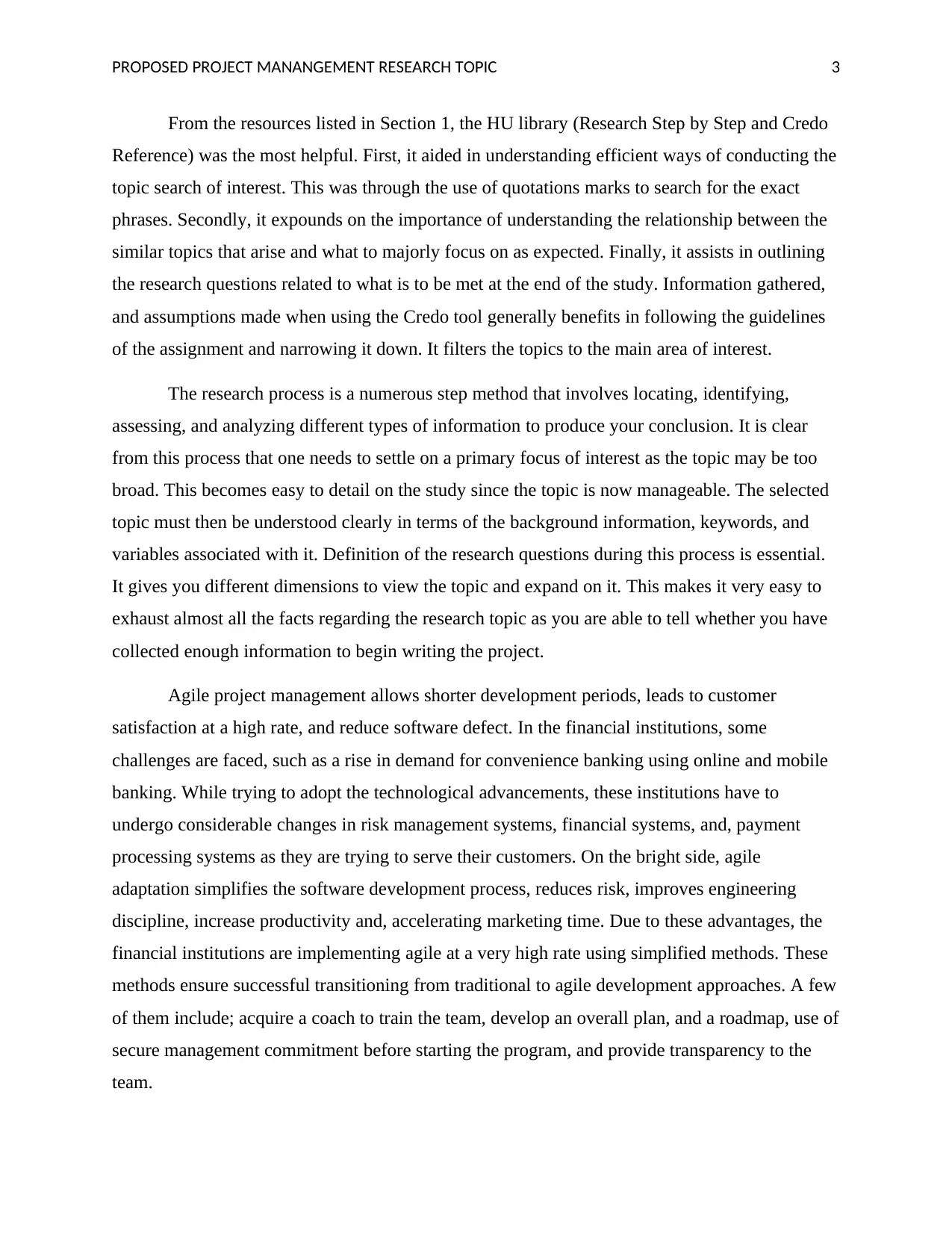
PROPOSED PROJECT MANANGEMENT RESEARCH TOPIC 3
From the resources listed in Section 1, the HU library (Research Step by Step and Credo
Reference) was the most helpful. First, it aided in understanding efficient ways of conducting the
topic search of interest. This was through the use of quotations marks to search for the exact
phrases. Secondly, it expounds on the importance of understanding the relationship between the
similar topics that arise and what to majorly focus on as expected. Finally, it assists in outlining
the research questions related to what is to be met at the end of the study. Information gathered,
and assumptions made when using the Credo tool generally benefits in following the guidelines
of the assignment and narrowing it down. It filters the topics to the main area of interest.
The research process is a numerous step method that involves locating, identifying,
assessing, and analyzing different types of information to produce your conclusion. It is clear
from this process that one needs to settle on a primary focus of interest as the topic may be too
broad. This becomes easy to detail on the study since the topic is now manageable. The selected
topic must then be understood clearly in terms of the background information, keywords, and
variables associated with it. Definition of the research questions during this process is essential.
It gives you different dimensions to view the topic and expand on it. This makes it very easy to
exhaust almost all the facts regarding the research topic as you are able to tell whether you have
collected enough information to begin writing the project.
Agile project management allows shorter development periods, leads to customer
satisfaction at a high rate, and reduce software defect. In the financial institutions, some
challenges are faced, such as a rise in demand for convenience banking using online and mobile
banking. While trying to adopt the technological advancements, these institutions have to
undergo considerable changes in risk management systems, financial systems, and, payment
processing systems as they are trying to serve their customers. On the bright side, agile
adaptation simplifies the software development process, reduces risk, improves engineering
discipline, increase productivity and, accelerating marketing time. Due to these advantages, the
financial institutions are implementing agile at a very high rate using simplified methods. These
methods ensure successful transitioning from traditional to agile development approaches. A few
of them include; acquire a coach to train the team, develop an overall plan, and a roadmap, use of
secure management commitment before starting the program, and provide transparency to the
team.
From the resources listed in Section 1, the HU library (Research Step by Step and Credo
Reference) was the most helpful. First, it aided in understanding efficient ways of conducting the
topic search of interest. This was through the use of quotations marks to search for the exact
phrases. Secondly, it expounds on the importance of understanding the relationship between the
similar topics that arise and what to majorly focus on as expected. Finally, it assists in outlining
the research questions related to what is to be met at the end of the study. Information gathered,
and assumptions made when using the Credo tool generally benefits in following the guidelines
of the assignment and narrowing it down. It filters the topics to the main area of interest.
The research process is a numerous step method that involves locating, identifying,
assessing, and analyzing different types of information to produce your conclusion. It is clear
from this process that one needs to settle on a primary focus of interest as the topic may be too
broad. This becomes easy to detail on the study since the topic is now manageable. The selected
topic must then be understood clearly in terms of the background information, keywords, and
variables associated with it. Definition of the research questions during this process is essential.
It gives you different dimensions to view the topic and expand on it. This makes it very easy to
exhaust almost all the facts regarding the research topic as you are able to tell whether you have
collected enough information to begin writing the project.
Agile project management allows shorter development periods, leads to customer
satisfaction at a high rate, and reduce software defect. In the financial institutions, some
challenges are faced, such as a rise in demand for convenience banking using online and mobile
banking. While trying to adopt the technological advancements, these institutions have to
undergo considerable changes in risk management systems, financial systems, and, payment
processing systems as they are trying to serve their customers. On the bright side, agile
adaptation simplifies the software development process, reduces risk, improves engineering
discipline, increase productivity and, accelerating marketing time. Due to these advantages, the
financial institutions are implementing agile at a very high rate using simplified methods. These
methods ensure successful transitioning from traditional to agile development approaches. A few
of them include; acquire a coach to train the team, develop an overall plan, and a roadmap, use of
secure management commitment before starting the program, and provide transparency to the
team.
⊘ This is a preview!⊘
Do you want full access?
Subscribe today to unlock all pages.

Trusted by 1+ million students worldwide
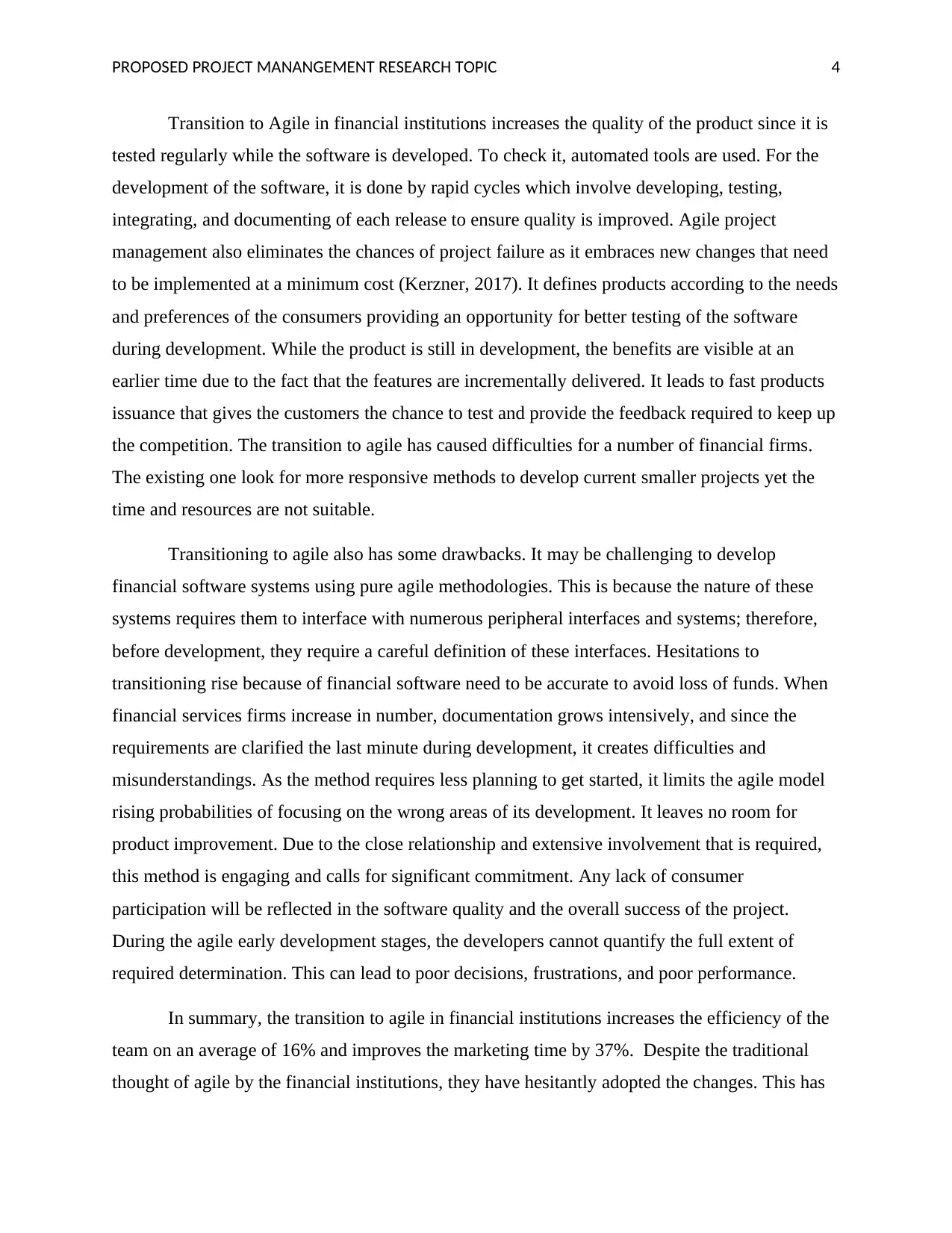
PROPOSED PROJECT MANANGEMENT RESEARCH TOPIC 4
Transition to Agile in financial institutions increases the quality of the product since it is
tested regularly while the software is developed. To check it, automated tools are used. For the
development of the software, it is done by rapid cycles which involve developing, testing,
integrating, and documenting of each release to ensure quality is improved. Agile project
management also eliminates the chances of project failure as it embraces new changes that need
to be implemented at a minimum cost (Kerzner, 2017). It defines products according to the needs
and preferences of the consumers providing an opportunity for better testing of the software
during development. While the product is still in development, the benefits are visible at an
earlier time due to the fact that the features are incrementally delivered. It leads to fast products
issuance that gives the customers the chance to test and provide the feedback required to keep up
the competition. The transition to agile has caused difficulties for a number of financial firms.
The existing one look for more responsive methods to develop current smaller projects yet the
time and resources are not suitable.
Transitioning to agile also has some drawbacks. It may be challenging to develop
financial software systems using pure agile methodologies. This is because the nature of these
systems requires them to interface with numerous peripheral interfaces and systems; therefore,
before development, they require a careful definition of these interfaces. Hesitations to
transitioning rise because of financial software need to be accurate to avoid loss of funds. When
financial services firms increase in number, documentation grows intensively, and since the
requirements are clarified the last minute during development, it creates difficulties and
misunderstandings. As the method requires less planning to get started, it limits the agile model
rising probabilities of focusing on the wrong areas of its development. It leaves no room for
product improvement. Due to the close relationship and extensive involvement that is required,
this method is engaging and calls for significant commitment. Any lack of consumer
participation will be reflected in the software quality and the overall success of the project.
During the agile early development stages, the developers cannot quantify the full extent of
required determination. This can lead to poor decisions, frustrations, and poor performance.
In summary, the transition to agile in financial institutions increases the efficiency of the
team on an average of 16% and improves the marketing time by 37%. Despite the traditional
thought of agile by the financial institutions, they have hesitantly adopted the changes. This has
Transition to Agile in financial institutions increases the quality of the product since it is
tested regularly while the software is developed. To check it, automated tools are used. For the
development of the software, it is done by rapid cycles which involve developing, testing,
integrating, and documenting of each release to ensure quality is improved. Agile project
management also eliminates the chances of project failure as it embraces new changes that need
to be implemented at a minimum cost (Kerzner, 2017). It defines products according to the needs
and preferences of the consumers providing an opportunity for better testing of the software
during development. While the product is still in development, the benefits are visible at an
earlier time due to the fact that the features are incrementally delivered. It leads to fast products
issuance that gives the customers the chance to test and provide the feedback required to keep up
the competition. The transition to agile has caused difficulties for a number of financial firms.
The existing one look for more responsive methods to develop current smaller projects yet the
time and resources are not suitable.
Transitioning to agile also has some drawbacks. It may be challenging to develop
financial software systems using pure agile methodologies. This is because the nature of these
systems requires them to interface with numerous peripheral interfaces and systems; therefore,
before development, they require a careful definition of these interfaces. Hesitations to
transitioning rise because of financial software need to be accurate to avoid loss of funds. When
financial services firms increase in number, documentation grows intensively, and since the
requirements are clarified the last minute during development, it creates difficulties and
misunderstandings. As the method requires less planning to get started, it limits the agile model
rising probabilities of focusing on the wrong areas of its development. It leaves no room for
product improvement. Due to the close relationship and extensive involvement that is required,
this method is engaging and calls for significant commitment. Any lack of consumer
participation will be reflected in the software quality and the overall success of the project.
During the agile early development stages, the developers cannot quantify the full extent of
required determination. This can lead to poor decisions, frustrations, and poor performance.
In summary, the transition to agile in financial institutions increases the efficiency of the
team on an average of 16% and improves the marketing time by 37%. Despite the traditional
thought of agile by the financial institutions, they have hesitantly adopted the changes. This has
Paraphrase This Document
Need a fresh take? Get an instant paraphrase of this document with our AI Paraphraser
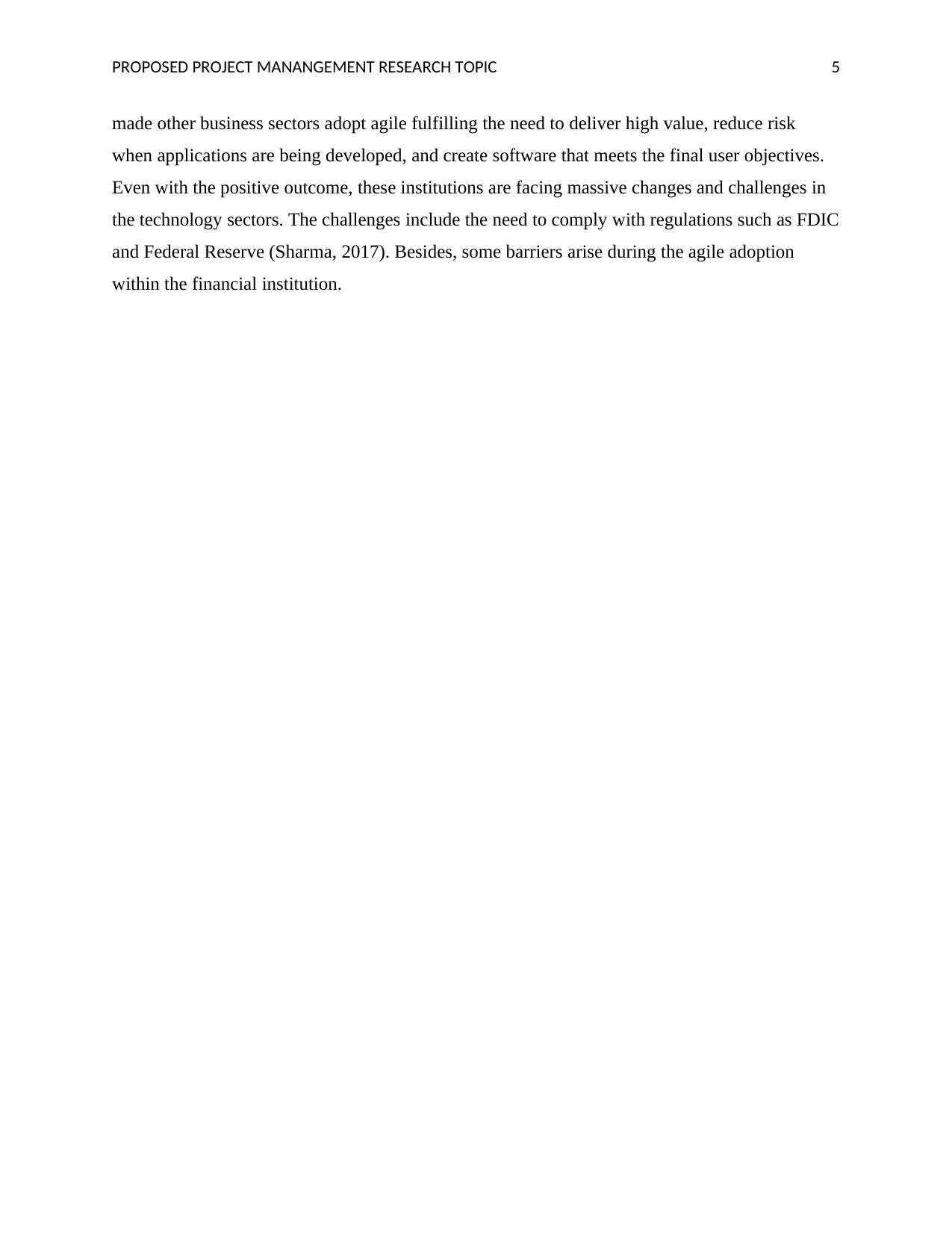
PROPOSED PROJECT MANANGEMENT RESEARCH TOPIC 5
made other business sectors adopt agile fulfilling the need to deliver high value, reduce risk
when applications are being developed, and create software that meets the final user objectives.
Even with the positive outcome, these institutions are facing massive changes and challenges in
the technology sectors. The challenges include the need to comply with regulations such as FDIC
and Federal Reserve (Sharma, 2017). Besides, some barriers arise during the agile adoption
within the financial institution.
made other business sectors adopt agile fulfilling the need to deliver high value, reduce risk
when applications are being developed, and create software that meets the final user objectives.
Even with the positive outcome, these institutions are facing massive changes and challenges in
the technology sectors. The challenges include the need to comply with regulations such as FDIC
and Federal Reserve (Sharma, 2017). Besides, some barriers arise during the agile adoption
within the financial institution.
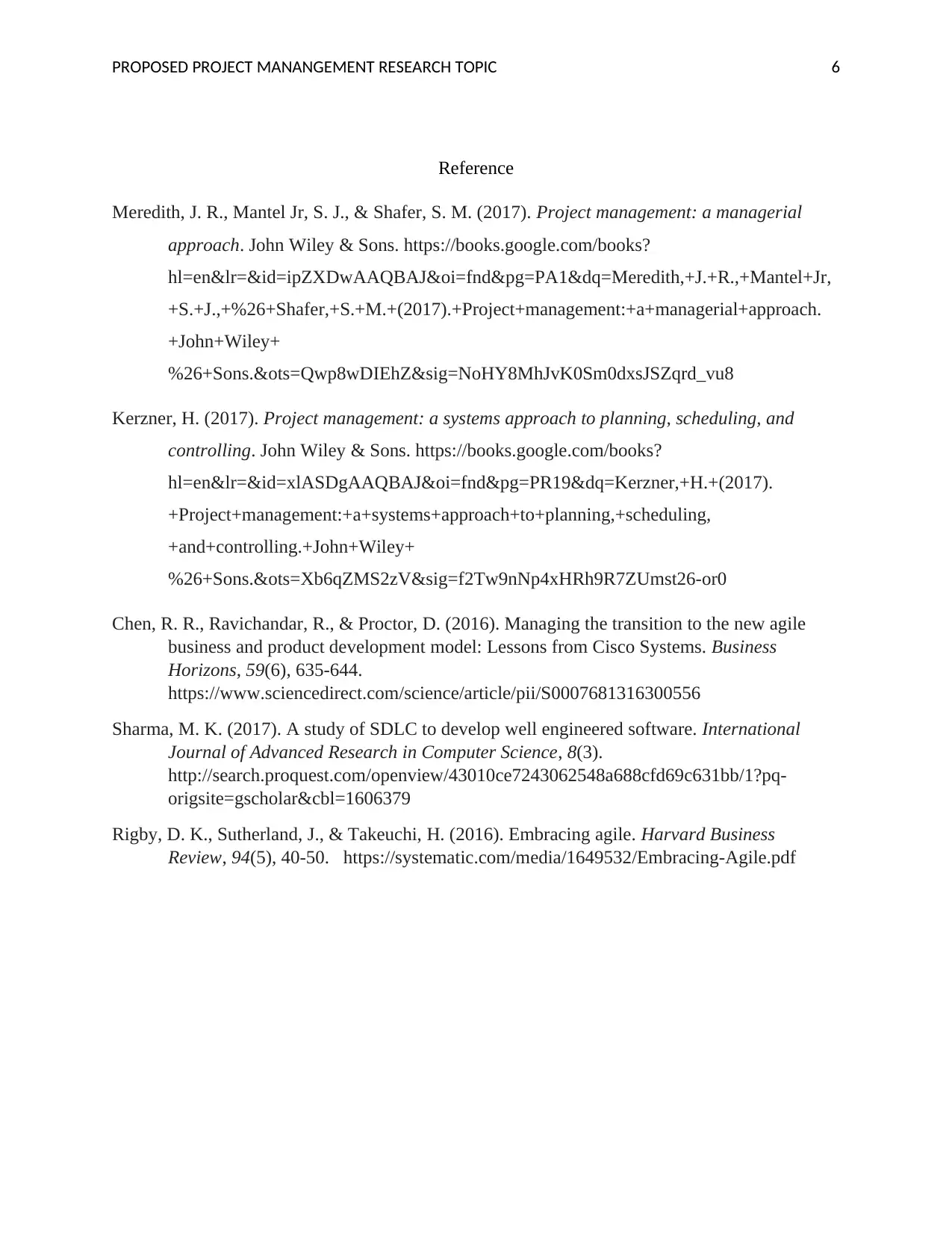
PROPOSED PROJECT MANANGEMENT RESEARCH TOPIC 6
Reference
Meredith, J. R., Mantel Jr, S. J., & Shafer, S. M. (2017). Project management: a managerial
approach. John Wiley & Sons. https://books.google.com/books?
hl=en&lr=&id=ipZXDwAAQBAJ&oi=fnd&pg=PA1&dq=Meredith,+J.+R.,+Mantel+Jr,
+S.+J.,+%26+Shafer,+S.+M.+(2017).+Project+management:+a+managerial+approach.
+John+Wiley+
%26+Sons.&ots=Qwp8wDIEhZ&sig=NoHY8MhJvK0Sm0dxsJSZqrd_vu8
Kerzner, H. (2017). Project management: a systems approach to planning, scheduling, and
controlling. John Wiley & Sons. https://books.google.com/books?
hl=en&lr=&id=xlASDgAAQBAJ&oi=fnd&pg=PR19&dq=Kerzner,+H.+(2017).
+Project+management:+a+systems+approach+to+planning,+scheduling,
+and+controlling.+John+Wiley+
%26+Sons.&ots=Xb6qZMS2zV&sig=f2Tw9nNp4xHRh9R7ZUmst26-or0
Chen, R. R., Ravichandar, R., & Proctor, D. (2016). Managing the transition to the new agile
business and product development model: Lessons from Cisco Systems. Business
Horizons, 59(6), 635-644.
https://www.sciencedirect.com/science/article/pii/S0007681316300556
Sharma, M. K. (2017). A study of SDLC to develop well engineered software. International
Journal of Advanced Research in Computer Science, 8(3).
http://search.proquest.com/openview/43010ce7243062548a688cfd69c631bb/1?pq-
origsite=gscholar&cbl=1606379
Rigby, D. K., Sutherland, J., & Takeuchi, H. (2016). Embracing agile. Harvard Business
Review, 94(5), 40-50. https://systematic.com/media/1649532/Embracing-Agile.pdf
Reference
Meredith, J. R., Mantel Jr, S. J., & Shafer, S. M. (2017). Project management: a managerial
approach. John Wiley & Sons. https://books.google.com/books?
hl=en&lr=&id=ipZXDwAAQBAJ&oi=fnd&pg=PA1&dq=Meredith,+J.+R.,+Mantel+Jr,
+S.+J.,+%26+Shafer,+S.+M.+(2017).+Project+management:+a+managerial+approach.
+John+Wiley+
%26+Sons.&ots=Qwp8wDIEhZ&sig=NoHY8MhJvK0Sm0dxsJSZqrd_vu8
Kerzner, H. (2017). Project management: a systems approach to planning, scheduling, and
controlling. John Wiley & Sons. https://books.google.com/books?
hl=en&lr=&id=xlASDgAAQBAJ&oi=fnd&pg=PR19&dq=Kerzner,+H.+(2017).
+Project+management:+a+systems+approach+to+planning,+scheduling,
+and+controlling.+John+Wiley+
%26+Sons.&ots=Xb6qZMS2zV&sig=f2Tw9nNp4xHRh9R7ZUmst26-or0
Chen, R. R., Ravichandar, R., & Proctor, D. (2016). Managing the transition to the new agile
business and product development model: Lessons from Cisco Systems. Business
Horizons, 59(6), 635-644.
https://www.sciencedirect.com/science/article/pii/S0007681316300556
Sharma, M. K. (2017). A study of SDLC to develop well engineered software. International
Journal of Advanced Research in Computer Science, 8(3).
http://search.proquest.com/openview/43010ce7243062548a688cfd69c631bb/1?pq-
origsite=gscholar&cbl=1606379
Rigby, D. K., Sutherland, J., & Takeuchi, H. (2016). Embracing agile. Harvard Business
Review, 94(5), 40-50. https://systematic.com/media/1649532/Embracing-Agile.pdf
⊘ This is a preview!⊘
Do you want full access?
Subscribe today to unlock all pages.

Trusted by 1+ million students worldwide
1 out of 6
Related Documents
Your All-in-One AI-Powered Toolkit for Academic Success.
+13062052269
info@desklib.com
Available 24*7 on WhatsApp / Email
![[object Object]](/_next/static/media/star-bottom.7253800d.svg)
Unlock your academic potential
Copyright © 2020–2025 A2Z Services. All Rights Reserved. Developed and managed by ZUCOL.





